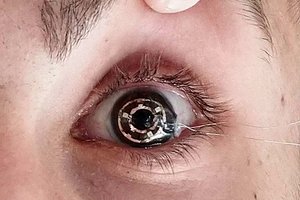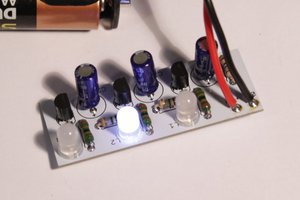Here you can see it in action:
And earlier version with only 3 LEDs, freeform construction and only recycled components:
In this version of the circuit the negative voltage spike at the base of the transistors is used to light up the LEDs, that's why there are only short flashes. It does look a bit like a flux capacitor, does it not?
I quickly found out that it's not possible to do what I wanted in KiCad (well, not without diving deeply into python scripting) - so I just exported a single branch to SVG and imported into inkscape. There I used the linked clones function to get 5 instances with a rotation angle of 72°. I also re-did the routing with bezier curves because I was going for an organic look. I used all 0603 parts (resistors, LEDs) and the transistors are PMST3904 in SOT-323, because SOT-23 is just so freaking humonguous. The caps are 47uF tantalums - i would have loved something less plasticky like MLCCs, but that would have necessitated a higher value for R1 which in turn would have diminished the rise-time of the resulting square wave. Well, maybe in a further version I will make that compromise.
Here is the schematic, only one of the 5 branches is shown, the falling edge occurring when Q1 turns on goes through C1 and turns off the next transistor (see dotted line). Q2 simply inverts the signal and drives the LED.

A quirk of the circuit is that it initially starts up with a semi-chaotic blink pattern, so I integrated a leaf-switch to short Q1 in one of the branches. After stopping the action at that one transistor the circuit has one single LED on at a time. The proper thing to do would have been to design a reset circuitry into the thing, but there was no more space on the board.
in KiCad:

in Inkscape:

From here I used the classic toner transfer process. I also learned that sodium-persulfate only works at 40°-50°,
Here is a failed attempt:

I also realized that it does not work with an even number of branches, at least I think that's what it was, so after I switched to heating the glass jar with the etchant in a water bath this pcb was made and depopulated again before I switched to the 5 branch version:

BTW, I used the dextrin coated paper from Pulsar, available through Digikey:

This stuff comes with a sealer film that prevents pitting in the copper traces, good stuff.
And why amber LEDs? Because it matches my nixie clocks.

 Alex
Alex
 Kelly Heaton
Kelly Heaton
 Chris
Chris
 Yann Guidon / YGDES
Yann Guidon / YGDES